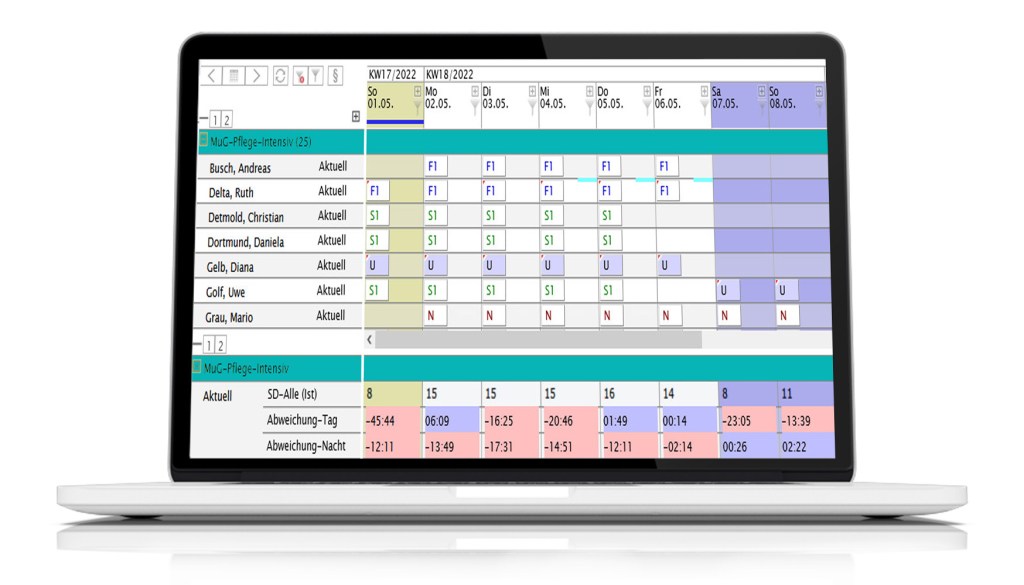PPBV (PPR 2.0) in the Healthcare Sector - Efficiency and Transparency Through Digital WFM Software

The new Nursing Staff Assessment Ordinance (PPBV) has been in force in all German hospitals since July 1, 2024.
The demands on the healthcare sector are constantly increasing, while a shortage of skill sand cost pressure are making everyday life more difficult. Standards such as the Nursing Staff Assessment Ordinance (PPBV) and the Nursing Staff Regulation 2.0 (PPR 2.0) are intended to provide a remedy and offer approaches for optimizing staff planning in hospitals, clinics, long-term care facilities, outpatient care, rehabilitation clinics and psychiatric facilities. With the help of WFM software, the new requirements can be implemented automatically and support efficient and legally compliant staff management, as well as providing transparent evidence of the same.
Contents
↓ What is PPBV / PPR 2.0?
↓ Who does PPBV / PPR 2.0 apply to?
↓ Why is PPBV / PPR 2.0 important in the healthcare sector?
↓ Who benefits from the integration of PPBV / PPR 2.0 and WFM?
↓ How does PPBV / PPR 2.0 work in conjunction with WFM software?
↓ How does PPBV / PPR 2.0 work with plano WFM?
What is PPBV / PPR 2.0?
PPBV and PPR 2.0 are regulations that are used to determine nursing staff requirements in hospitals and care facilities on the basis of patient data. They analyze the number of employees and which employees are required based on the current nursing workload. The standards are intended to ensure that sufficient nursing staff is on shift by evaluating detailed information on patients’ state of health and nursing time and taking this into account during staff planning processes.
The aim is to enable needs-based staff planning in order to avoid overstaffing and understaffing, which in the past often led to inefficiencies and staff overwork.
You can find more information on the subject of staffing level analysis at: https://plano-wfm.com/en/staffing-level-analysis/
Who does PPR 2.0 apply to?
The PPR 2.0 regulations apply to all hospitals that fall under the Hospital Remuneration Act. This includes normal wards with beds for adults in acute clinics as well as corresponding wards for children, both normal and intensive care units.
PPR 2.0 is aimed in particular at the following professional groups:
- Certified nursing staff in accordance with the Nursing, Elderly Care and Nursing Professions Act
- Nursing assistants with state-recognized assistant or helper training
- Nursing assistants with training in nursing or geriatric nursing assistance
- Nursing assistants with a permit to work as a nursing assistant in accordance with the Nursing Act
- Nursing assistants in healthcare professions who meet the requirements of the nursing staff cost delimitation agreement
- Midwives who are also permitted to work as nurses
There are exceptions to the PPR 2.0 for certain areas, such as outpatient clinics, anesthesia or dialysis.
Why is PPBV / PPR 2.0 important in the healthcare sector?
The healthcare sector is under great pressure. Nurses & care givers are often overworked, which affects both their satisfaction and the quality of care. PPBV / PPR 2.0 should help to solve these problems by determining the actual nursing workload precisely and based on real data. This should ensure a fairer distribution of work and better planning of staffing and patient care.
Particularly in times of staff shortages, PPBV / PPR 2.0 provide a structured and flexible basis for ensuring that sufficient nursing staff are always deployed where they are really needed.

Who benefits from the integration of PPBV / PPR 2.0 and WFM?
The benefits of integrating PPBV / PPR 2.0 into WFM software are far-reaching and affect various interest groups in the healthcare sector:
- Nursing staff: automated and equitable shift scheduling reduces stress and allows for more flexible working hours. Thanks to the dynamic adjustment to care requirements, the workload is distributed more evenly.
- Patients: Demand-oriented staff planning increases patient safety and the quality of care. Patients benefit from the improved availability and attentiveness of nursing staff.
- Hospitals and care facilities: Integration enables more efficient staff management, which both reduces personnel costs and improves the quality of care. The improved transparency and traceability also make it easier to comply with legal requirements and internal quality standards.
- Healthcare system and payers: Better staff efficiency means that resources are used in a targeted and sensible manner. In the long term, this has a positive effect on the financial stability of the healthcare system.
How does PPBV / PPR 2.0 work in conjunction with WFM software?
The combination of PPBV / PPR 2.0 with WFM software opens up completely new possibilities for personnel management. Workforce management software is a digital tool that maps the entire workforce planning process, from determining requirements to shift scheduling and real-time monitoring.
This is how integration works:
- Connection to HIS system (hospital information system): Our application from plano WFM is technically designed so that it can be connected to any HIS system. Patient/occupancy data is transferred file-based to the PPBV solution in a predefined format.
*HIS – A hospital information system is a software solution that manages and coordinates all important data and processes in a hospital. - Automated planning: By integrating PPBV / PPR 2.0 into WFM software, the requirements of the two regulations can be automatically taken into account in the shift schedule. The data on the patients and their care requirements flows directly into the WFM system, which calculates the ideal staffing levels on this basis and plans the deployment of staff efficiently.
- Real-time adjustments: If care requirements change suddenly, e.g. due to unexpected emergencies or staff shortages, the WFM system can react in real time and dynamically adjust staff deployment. This minimizes the risk of over- or understaffing.
- Transparency and traceability: The integration of both regulations enables seamless documentation of care expenditure and staff deployment. This not only helps with quality control, but also with budget planning and compliance with legal requirements.
- Optimization of working hours: WFM tools can be used to better manage overtime, days off and sickness cover. In conjunction with PPBV / PPR 2.0 data, this ensures that nursing staff are not only allocated efficiently but also fairly.
How does PPBV/PPRL 2.0 work with plano WFM?
The PPBV is an add-on and can be called up both in the plano Roster and as a stand-alone web application.
The PPBV data is transferred to the plano Roster for the planning process in the form of day/night deviation and as a cumulative value for each planning group.

For transmission to InEK GmbH*, the results are provided in a report for an easy transfer to the data portal.
* https://de.wikipedia.org/wiki/Institut_für_das_Entgeltsystem_im_Krankenhaus
Conclusion
The combination of PPBV / PPR 2.0 with modern WFM software marks a decisive step in the optimization of staff management in the healthcare sector. This combination not only creates greater efficiency, but also improves working conditions for nursing staff and the quality of patient care. Hospitals and care facilities that rely on such digital solutions will be in a better position to meet the challenges of the shortage of skilled staff and the increasing demand for care. The future of healthcare lies in intelligent and dynamic planning – and this is exactly what the symbiosis of PPBV / PPR 2.0 with workforce management software offers.
You can also read our blog post on the topic of “Implementing PpUGV with workforce management: https://plano-wfm.com/en/minimum-nursing-staff-limits-for-hospitals/
Would you like find out more?
Further information about our workforce management software and the areas of application here:
→ Workforce Management from plano
Archive
Employee Retention in Retail
We’re Here for You
